
Original text: Robert Osborne, Outlier Ventures
Translation: Yuliya, PANews
There may be misunderstandings about Web3 fundraising among many people. Within the industry, the tug-of-war between infrastructure projects and consumer-facing projects has become one of the longest discussions. According to a post by Claire Kart, Chief Marketing Officer of Aztec Network, on X, infrastructure projects seem to be overly favored in the Web3 industry.
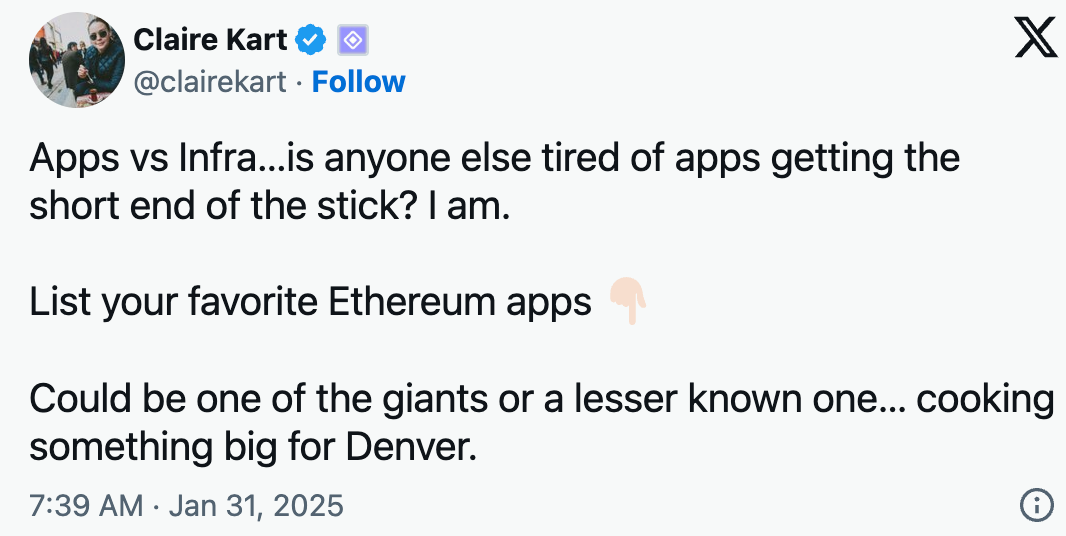
Figure 1: Claire Kart, Chief Marketing Officer of Aztec Network
But things are often not as they appear. What if our previous assumptions about venture capital preferences are actually wrong? What if, in fact, consumer projects are the ones benefiting more?
Web3 Fundraising: Defining the Issue
In the venture capital field, the common view is that infrastructure projects have received significant attention from investors, and "infrastructure" seems to dominate the venture capital market, leading to a shortage of funding for consumer projects.

Figure 2: Hira Siddiqui, Founder of Plurality Network
In this discussion, it is first necessary to define the basic concepts. The arguments and friction between the two sides may partly stem from the confusion between "consumer projects" and "infrastructure projects." Here are definitions for these two types of projects.
- Consumer Projects: These projects aim to interact directly with end users, providing tools, services, or platforms that meet individual or retail needs. Consumer projects typically focus on enhancing user experience, providing financial services, promoting entertainment, and increasing community engagement. End users are the primary consumer group for these projects. These solutions are usually more user-friendly, prioritizing the immediate needs of individuals or businesses without requiring users to have extensive technical backgrounds.
- Infrastructure Projects: These projects form the foundation of decentralized systems, focusing on building the core technological layers that support secure, scalable, and interoperable networks. They include blockchain protocols, verification systems, cross-chain interoperability, and other technologies that support the operation of other applications and services. Deep infrastructure is often invisible to end users but is crucial for the performance and reliability of the entire system. These projects primarily target developers, node operators, and those responsible for maintaining and scaling blockchain systems.
According to fundraising data from Messari, the classification of industry projects does not need to be redefined and can be directly applied to the existing framework.
Consumer application projects include: consulting and advisory services, cryptocurrencies, data, entertainment, financial services, governance, human resources and community tools, investment management, markets, metaverse and gaming, news and information, security, synthetic assets, and wallets.
Infrastructure projects include: network and web services, node tools, cross-chain interoperability, networks, physical infrastructure networks, computing networks, mining and verification, developer tools, and consumer infrastructure.
It is important to note that the boundaries of the "consumer infrastructure" category are somewhat blurred. It supports the framework for user-facing applications but may not be directly visible. For the purposes of this article, "consumer infrastructure" will be considered as infrastructure projects.
The Significance of the Debate
Why is this debate so important? Why do founders and investors feel the need to draw a line on this issue? Recently, Boccaccio from Blockworks, Mike Dudas from 6th Man Ventures, and Haseeb Qureshi from Dragonfly briefly discussed this issue in a panel at the 2025 New York DAS Conference, but their brief exchange was not enough to resolve the matter.

Figure 3: New York Digital Asset Summit, "Is Venture Capital Still Important?", Boccaccio (left), Haseeb Qureshi (middle), Mike Dudas (right).
Infrastructure supporters believe they are the "invisible architects" of the on-chain future, asserting that digital railways must be laid before consumers can move forward at high speed. Without sufficient scalability to handle traffic surges and a lack of robust security measures to guard against attacks and vulnerabilities, widespread adoption can only be a pipe dream. As Haseeb Qureshi stated in the panel discussion, "Have we built the blockchain yet? Is this the final form? If we want more than 10 million people to use public chains, we are not done yet."

Figure 4: Antonio Palma
By investing in technological research and development, the goal is to simplify the construction process, reduce friction for the next dApp creator, and ultimately achieve widespread interaction between blockchain and users. This is not just a short-term bet but a long-term plan: to build infrastructure that paves the way for the smooth delivery of powerful consumer dApps.
On the other hand, supporters of consumer projects criticize the existing system for being heavily biased towards infrastructure projects, with even the most successful consumer applications considering a shift towards infrastructure: Uniswap is building a modular AMM framework, Coinbase has launched its own L2, and even social applications like Farcaster are beginning to position themselves as social protocols.
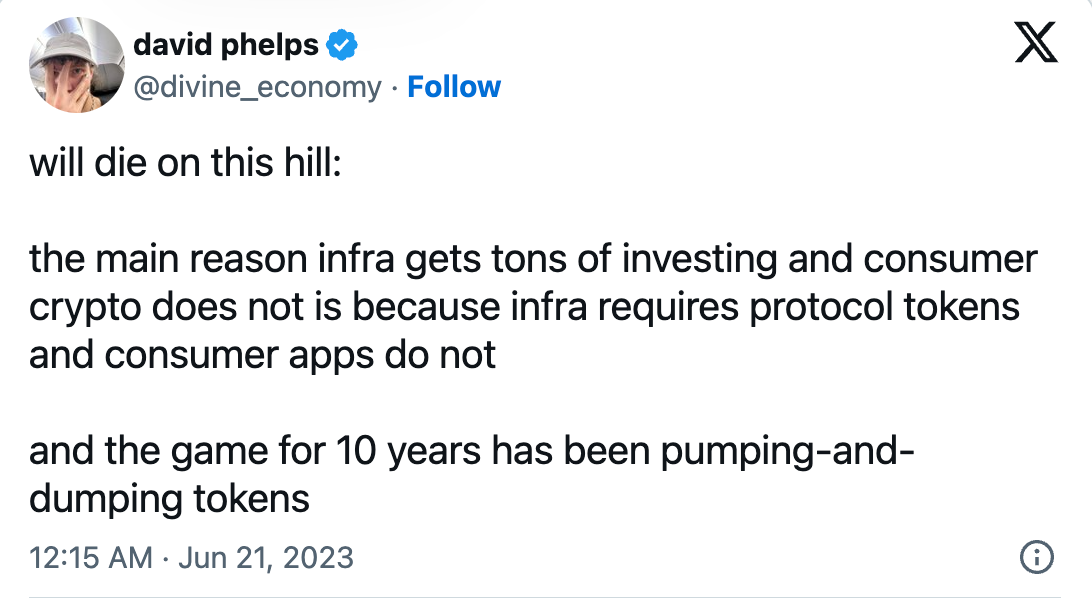
Figure 5: David Phelps, Co-founder of JokeRace
As Mike Dudas mentioned in the panel discussion, the current market structure means that infrastructure projects are default "darlings" in the eyes of venture capitalists, even though the actual liquidity involved in these projects is not high.
Therefore, supporters of consumer projects argue that the role of venture capital is a form of artificial market distortion: if more capital could be allocated to consumer applications, then large-scale adoption could be achieved. Cumbersome wallets and complex interfaces are the biggest barriers to entry, making the most powerful blockchains almost invisible to the public. What truly drives the market is "killer applications." While efficient and secure infrastructure is crucial, if the seats are uncomfortable and the journey experience is poor, no one will want to buy a ticket.
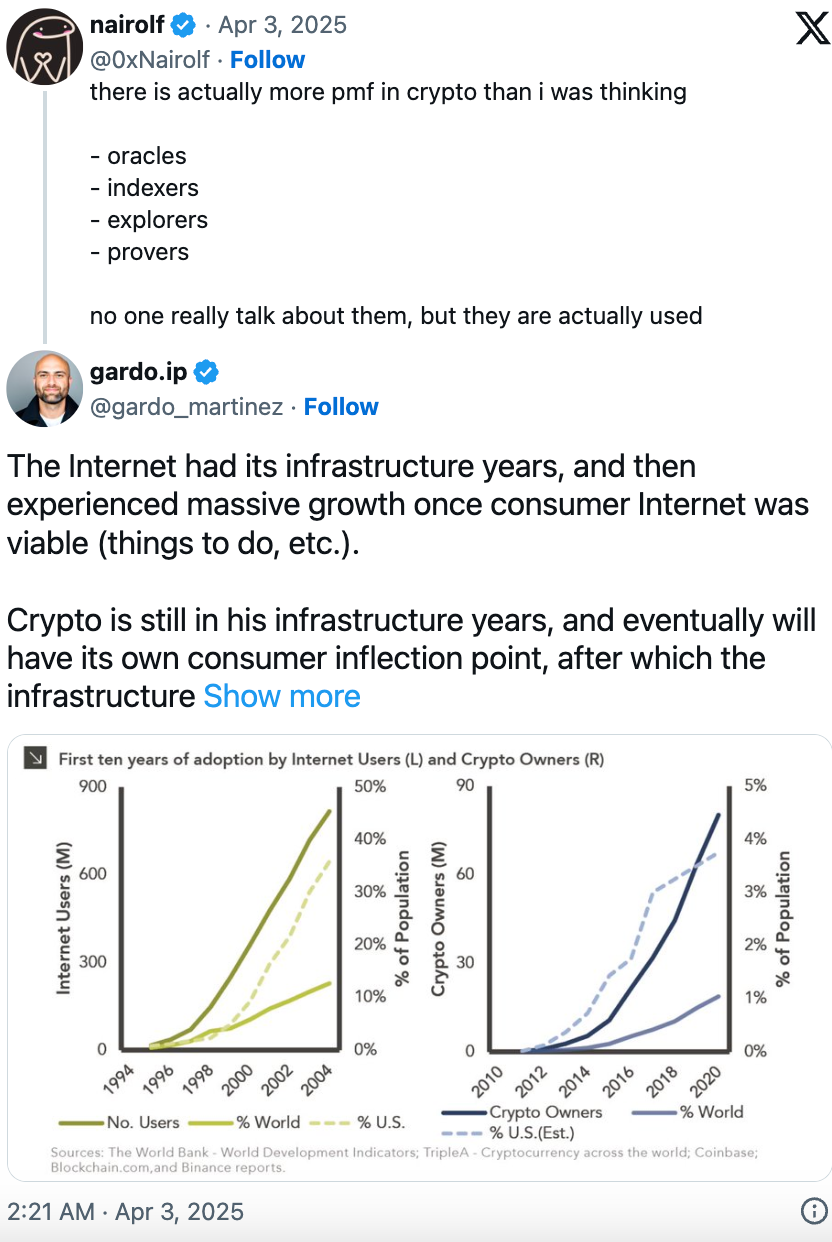
Figure 6: Gardo Martinez, Senior Product Manager at Story Protocol
The funding structure in the Web3 space has long been dominated by a common assumption: infrastructure projects should receive more capital support. The logic behind this view is that Web3 is still in its early stages of development, and the underlying infrastructure has not yet fully matured, so the market's attention to infrastructure projects will be higher than that for consumer-facing applications.
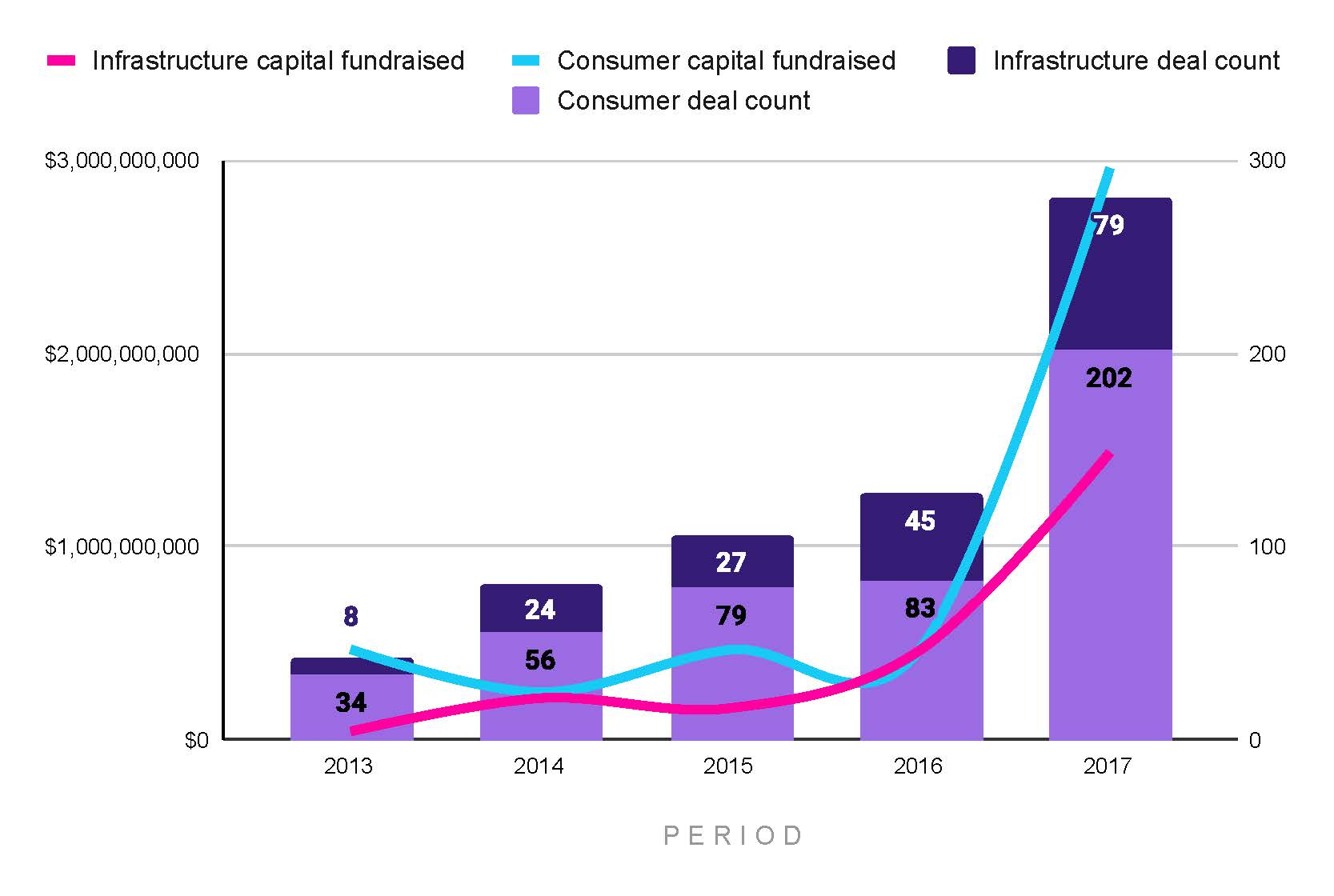
Figure 7: Funding amounts and transaction numbers for consumer and infrastructure projects from 2013 to 2017
However, early data reveals a different trend (see Figure 7). Starting from 2013, from 2013 to 2017, 72% of funding transactions came from consumer projects, while infrastructure projects accounted for only 33% of the total fundraising amount. Although in 2014 and 2016, the total funding amounts for both types of projects were once equal, the number of successfully funded consumer projects that year was still greater, indicating that while infrastructure projects had fewer funding rounds, the amount per round was larger (see Figure 12). By 2017, consumer projects once again dominated Web3 venture capital.
Overall, the capital investment during this period was just a drop in the bucket compared to the scale of subsequent years and could not constitute the core support of the Web3 ecosystem. Also, due to the limited data sample, the analysis of this stage is independent of the main discussion. From 2018 to 2024, a large amount of capital flowed in, and early venture capital interest was relatively insignificant.
Even so, this preliminary data raises some key questions: Did infrastructure projects really receive more funding support than consumer projects? Is the perception built on a false premise?
Is There a Preference for Consumer Projects?
Looking at the Web3 fundraising data from 2018 to 2024, a recent trend has emerged where infrastructure projects are receiving additional attention, while consumer applications have attracted more investors.
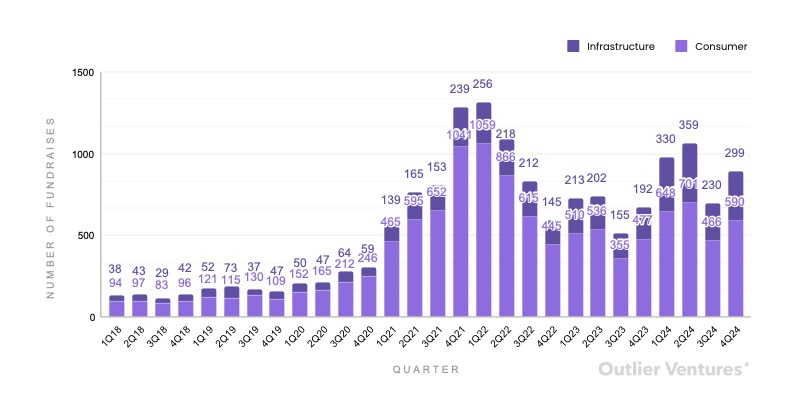
Figure 8: Total number of funding projects for infrastructure and consumer projects from 2018 to 2024, divided by quarter
From 2018 to 2024, consumer applications accounted for 74% of all funding transactions. Even in 2023 and 2024, consumer applications still accounted for 68% of all funding transactions (see Figure 8).
However, in terms of total funding amounts, the fate of infrastructure projects has changed. From 2018 to 2020, infrastructure projects lagged behind consumer applications, with only 11% of capital flowing to infrastructure projects. In 2021, this trend began to shift, although consumer projects still accounted for the majority of funding shares. In 2021 and 2022, infrastructure projects accounted for 19% of the funding capital, while this proportion reached 25% and 43% in 2023 and 2024, respectively (see Figure 9). In fact, from the fourth quarter of 2023 to the second quarter of 2024, infrastructure projects surpassed consumer projects in total funding amounts. 
Figure 9: Total funding amounts for consumer and infrastructure projects by quarter from 2018 to 2024
Another dimension worth noting is investor participation. Despite the view that most investors prefer infrastructure investments, data from 2018 to 2024 shows that the number of investors participating in consumer projects has consistently been higher. Particularly between 2021 and 2022, 79% of investor transactions occurred in consumer projects (see Figure 10).
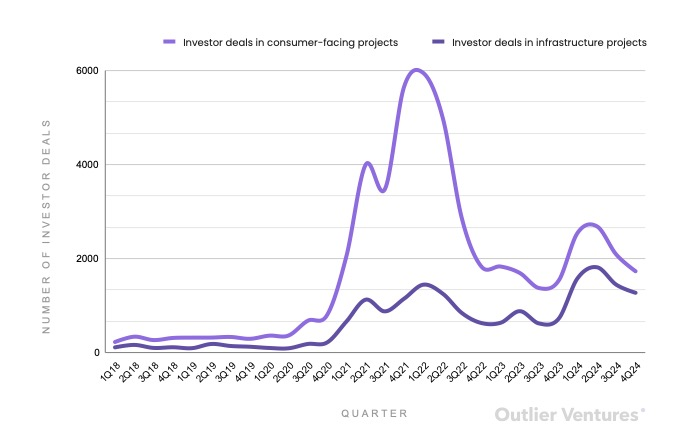
Figure 10: Total number of investor transactions for consumer and infrastructure project categories by quarter from 2018 to 2024
Although there was a delay in capital inflow to consumer projects at the beginning of the pandemic, this aligns with the typical 6 to 9 months funding cycle. The pandemic lockdowns shifted people's attention and disposable income online, sparking a surge in Web3 consumer applications.
However, this surge was not sustainable. The market crash in the second quarter of 2022 is widely believed to have been triggered by the collapse of Terra/Luna in May. After UST lost its peg, the market value evaporated by over $40 billion in an instant, triggering a chain reaction. Major funds like Three Arrows Capital and Celsius faced significant failures, exposing the vulnerabilities of the DeFi system. Coupled with macro pressures such as rising inflation, increasing interest rates, and tightening liquidity, the entire crypto market fell into crisis. The bankruptcy of FTX in November 2022 further exacerbated the collapse of market confidence.
From a venture capital perspective, the rebound of the crypto market at the end of 2023 and into 2024 has not been mirrored in the VC market. The reason is that the market is still in a "hangover" phase following the consumer boom during the pandemic. The investment returns from the fourth quarter of 2020 to the fourth quarter of 2023 did not meet expectations, revealing the premature nature of consumer investments and the immaturity of crypto VCs. Although the number of investor transactions in consumer projects remains leading, the gap between infrastructure and consumer projects has noticeably narrowed. In 2024, infrastructure projects accounted for 40% of investor transaction numbers.
This is not a phenomenon unique to Web3. Between 2020 and 2021, a large amount of capital flowed into the traditional VC market. Private equity investor “@carrynointerest” pointed out that the capital misallocation during this phase would lead to a long-term wave of VC failures. The lack of merger and acquisition exits, rising interest rates, and declining software valuations have left many VC-backed companies as "orphans" or "zombie" companies.
When comparing the total funding amounts in Web3 with the number of traditional VC unicorns, the trends are highly similar (see Figure 11). As shown in Figures 8, 9, 10, and 12, consumer projects have long dominated capital and transaction shares. The failures of VCs in the Web3 space are essentially failures of consumer projects. Based on this understanding, investors should shift their focus towards infrastructure. 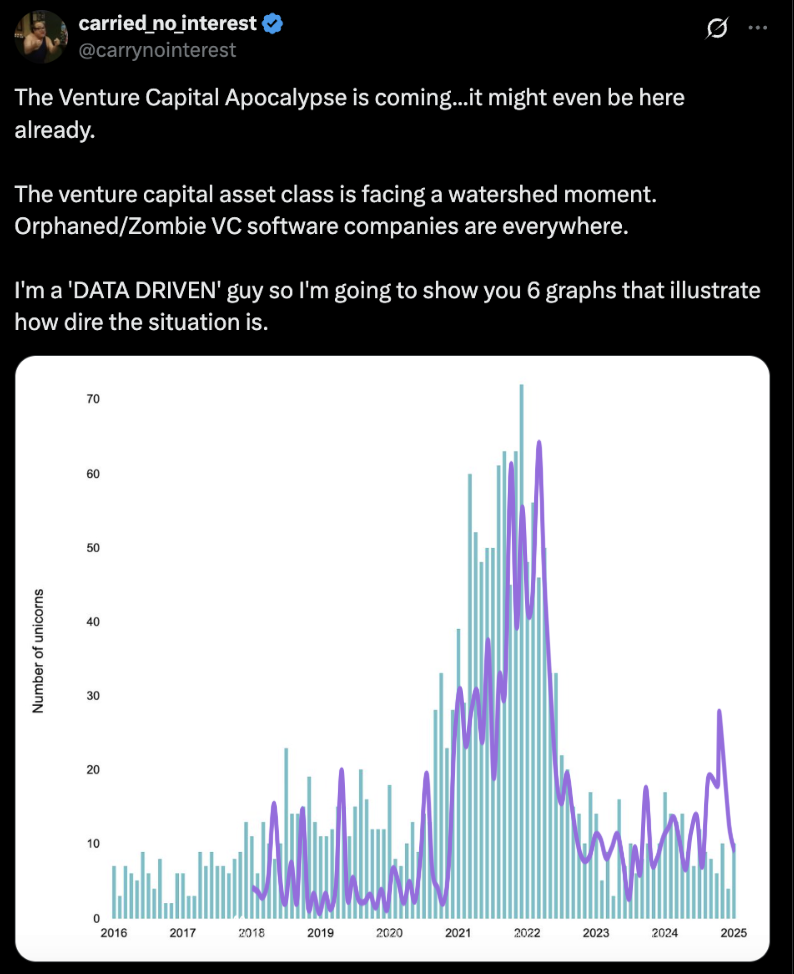
Figure 11: The number of startup unicorns from 2016 to 2025, along with the total funds raised by Web3 consumer and infrastructure projects
However, in reality, the adjustment of capital allocation towards consumer projects remains limited. This is closely related to the financing mechanisms of Web3. Unlike traditional equity, token-based financing mechanisms allow for partial exits before a project is fully realized, enabling investors to achieve some returns even in the face of failed projects.
Additionally, Web3 infrastructure projects often have longer development cycles and higher requirements for protocol security and token economic models, typically employing longer lock-up and unlocking mechanisms. Their tokens usually play a core role in network operations (such as staking or governance), so short-term concentrated unlocking must be avoided. In contrast, consumer projects pursue market speed, user growth, and early liquidity, often designing shorter lock-up periods to quickly capture market enthusiasm and speculative demand.
This structural difference creates a cyclical effect of capital: early liquidity generated by a consumer project feeds back into the next project, continuously driving investment in that track and cushioning the impact of failures. For this reason, the Web3 VC market has, to some extent, avoided the severe corrections experienced by traditional VCs.
As a supplementary metric, the total funding amounts can be combined with the number of funding rounds to calculate the median round sizes for consumer and infrastructure projects, along with the number of investor transactions to depict their funding paths (see Figure 12).
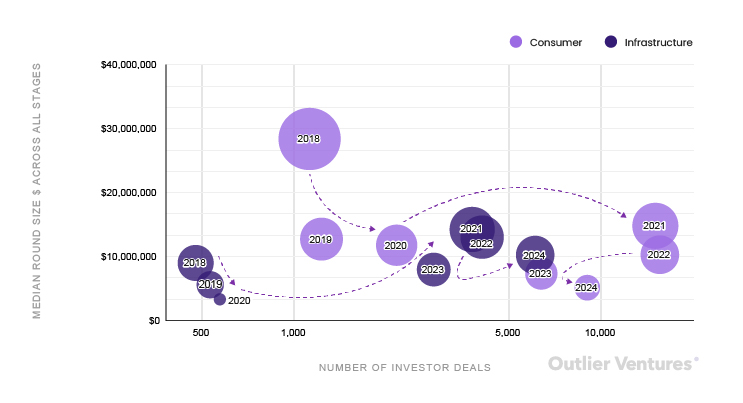
Figure 12: Median funding rounds and corresponding annual investor transaction numbers for consumer and infrastructure projects from 2018 to 2024
- From 2018 to 2020, consumer projects dominated the market. In 2021, the median funding sizes of the two types of projects came close for the first time (consumer projects at $14.8 million, infrastructure at $14.2 million), but the number of investor transactions for consumer projects was still four times that of infrastructure.
- Starting in 2022, the median rounds for infrastructure surpassed those of consumer projects for the first time ($13 million vs. $11 million), and this trend continued until 2024.
- In 2024, the median funding size for infrastructure projects was twice that of consumer projects.
Despite the increasing funding size for infrastructure, the number of investor transactions in consumer projects remains leading. In 2024, the number of investor transactions for these projects was 50% higher than that for infrastructure. This indicates that consumer projects are diverse and still attractive (see Figures 9 and 10).
Risk Preference Index
To more systematically measure venture capital preferences, the study introduced a "Risk Preference Index" (see Figure 13), which integrates capital share, transaction number share, and investor share, with a score range of 0 to 1, where 0.5 is neutral. The weights of the three indicators are: capital share 50%, transaction number 30%, investor share 20%. Among these, capital share is the strongest signal, representing high due diligence and strong expectations; transaction number reflects market breadth, but there is significant variance in individual transaction sizes; the number of investors reveals market enthusiasm, although the signal-to-noise ratio is relatively low.
So far, there has not been a case where infrastructure projects scored higher than consumer projects on this index. The closest instance occurred in the first quarter of 2024, when infrastructure scored 0.48. Essentially, this index can be seen as a barometer of VC confidence.
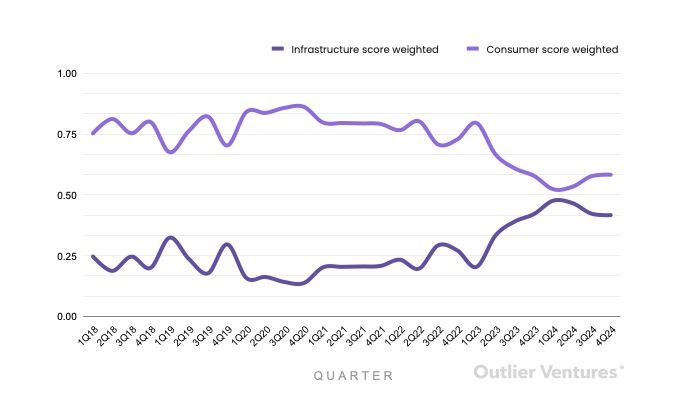
Figure 13: Risk Preference Score
Rethinking Capital Allocation in Web3 Financing
Regarding the funding ratio between consumer and infrastructure projects, there is no "correct" answer, as it depends on market maturity, phase-specific demands, and environmental changes. In emerging technology ecosystems like Web3, it is natural for infrastructure projects to attract significant capital in the early stages. The infrastructure layer requires more time to build and typically exhibits a "winner-takes-all" dynamic, making large-scale concentrated investments a reasonable choice. Infrastructure can unlock scale, performance, and security, all of which are prerequisites for achieving widespread consumer adoption. In this context, venture capital's preference for infrastructure seems reasonable.
However, the data reveals another story. Venture capital has consistently favored consumer projects, and the market behaves as if the infrastructure issues have been resolved, at least for now.
This mismatch raises important questions. Has the industry prematurely shifted its focus to consumer applications without adequately testing the infrastructure? Are we placing too much emphasis on short-term liquidity in capital allocation while neglecting long-term robustness? Or have we underestimated the existing maturity of infrastructure, thereby overlooking the user experience aspects that will drive mass adoption?
These are not binary choices, and in Web3, capital allocation should reflect the true maturity of the ecosystem rather than the state we wish it to achieve. The path forward lies not in favoring one side but in recalibrating confidence with reality.
免责声明:本文章仅代表作者个人观点,不代表本平台的立场和观点。本文章仅供信息分享,不构成对任何人的任何投资建议。用户与作者之间的任何争议,与本平台无关。如网页中刊载的文章或图片涉及侵权,请提供相关的权利证明和身份证明发送邮件到support@aicoin.com,本平台相关工作人员将会进行核查。




